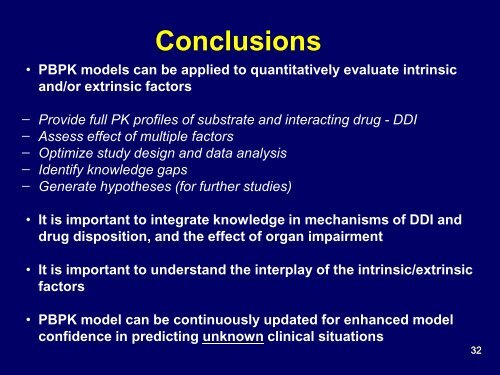Experience In Using PBPK Models in Clinical Pharmacology Reviews
Experience In Using PBPK Models in Clinical Pharmacology Reviews
Experience In Using PBPK Models in Clinical Pharmacology Reviews
You also want an ePaper? Increase the reach of your titles
YUMPU automatically turns print PDFs into web optimized ePapers that Google loves.
Conclusions<br />
• <strong>PBPK</strong> models can be applied to quantitatively evaluate <strong>in</strong>tr<strong>in</strong>sic<br />
and/or extr<strong>in</strong>sic factors<br />
̶ Provide full PK profiles of substrate and <strong>in</strong>teract<strong>in</strong>g drug - DDI<br />
̶ Assess effect of multiple factors<br />
̶ Optimize study design and data analysis<br />
̶ Identify knowledge gaps<br />
̶ Generate hypotheses (for further studies)<br />
• It is important to <strong>in</strong>tegrate knowledge <strong>in</strong> mechanisms of DDI and<br />
drug disposition, and the effect of organ impairment<br />
• It is important to understand the <strong>in</strong>terplay of the <strong>in</strong>tr<strong>in</strong>sic/extr<strong>in</strong>sic<br />
factors<br />
• <strong>PBPK</strong> model can be cont<strong>in</strong>uously updated for enhanced model<br />
confidence <strong>in</strong> predict<strong>in</strong>g unknown cl<strong>in</strong>ical situations<br />
32



